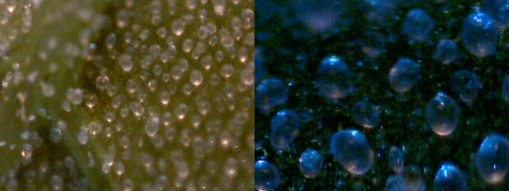Goosefoot
By Mike on Monday, August 25, 2008, 20:59 - Permalink
Out picking blackberries, I also returned home with some goosefoot that I picked from a weedy, recently-ploughed corner of a field.
What is Goosefoot?
Chenopodium spp - relatives of spinach, this genus comprises a number of smallish, bushy weeds with leaves approximately the shape of a goose's foot (hence one of the common names). Other plants in this group have common names such as Fat Hen, Maple-Leaved Goosefoot, Lamb's Quarters and Good King Henry.
They're not easy to tell apart from each other, but they're all edible, so it doesn't really matter. One of the key identification factors for this group of plants is that they all have leaves coated on the underside with a layer of grainy, mealy whitish crystalline stuff - which rubs off easily onto the hands while picking - here's a picture of it at 60x and 200x magnification:

Picking Goosefoot
The plant is a common weed of recently-dug soil, so it may be found in abundance in many gardens, allotments and fields (you should always seek the permission of the land owner if gathering it on someone else's property).
It grows very fast and quickly becomes fibrous - but even in older specimens, as long as the tops can be picked off easily by hand, they will be good to eat.
The whole plant can be eaten - leaves, stems, flower or seed clusters - indeed one species of Chenopodium is the source of a grain-like food known as Quinoa.
As a relative of spinach, the leaves and tender stems of this plant can be used as a direct substitute - steamed or wilted with butter, or combined with eggs in an omelette or quiche, but my favourite way to cook it is to dip the tops in a light batter and fry them until crisp.
Goosefoot Tempura With Chilli And Plum Dip
This is my favourite way to enjoy this fantastic wild green vegetable - fried in a light batter.
I start with some goosefoot tops - about three-inch pieces off the top of the plant, complete with the inflorescences, rinsed to remove any soil or other foreign bodies.
It actually helps if they're left to wilt for an hour - as they're easier to coat with the batter that way.
The batter is just a simple mixture of plain wheat flour, water, dried mixed herbs and a pinch of salt. A gram flour batter would also probably work well here - and it could be flavoured with pungent spices.
I fried the batter-coated shoots a few at a time in some hot oil, turning once and draining on a sheet of kitchen paper towel. They take only a minute or two each side.
And that's all there is to it - The heat of frying is just enough to turn the leaves into vivid green, tender perfection, coated in a crisp shell of batter.
For the dip, I just took a couple of teaspoons of my spiced plum chutney and mixed in a little bottled chilli and garlic table sauce.
